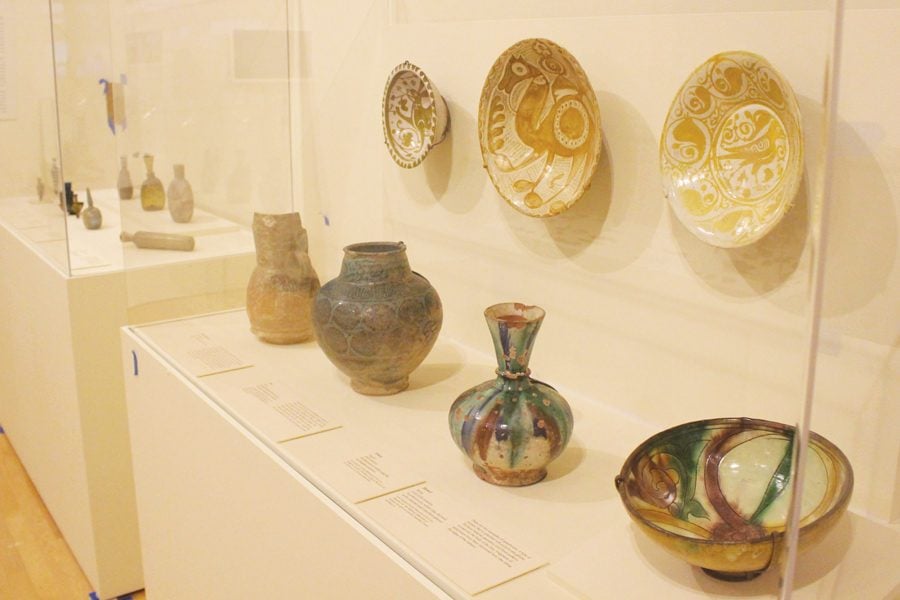“Caravans of Gold” exhibition presents first-of-its-kind look into medieval African art, trade
Evan Robinson-Johnson/The Daily Northwestern
Ceramic vases, among other African artifacts, are on display in “Caravans of Gold, Fragments in Time: Arts, Culture and Exchange Across Medieval Saharan Africa.” The exhibition opens this Saturday and will be at The Block Museum of Art through July 21.
January 23, 2019
To many involved in the art world, notions of exhibitions featuring “the medieval period” may conjure images of Byzantine crosses encrusted with jewels, European saints and castles featured in Gothic paintings and a world untouched by the globalized trade of goods and ideas. But curator Kathleen Bickford Berzock intends to present a vastly different portrait of the medieval world.
In “Caravans of Gold, Fragments in Time: Arts, Culture and Exchange Across Medieval Saharan Africa,” which will open at the Block Museum of Art this Saturday, Berzock weaves an artistic narrative of a wealthy African king, the journey of gold from West Africa to Florence, Italy and the expansion of Islamic culture and language.
“I’ve always been really interested in telling stories about the medieval history of Africa through its arts,” said Berzock, who is the associate director of curatorial affairs at the Block. “Now I’ve committed seven years to doing that. This exhibition shows that history requires active imagination. There are facts, but we also need to see that through mind’s eye. That’s what art and archeology contribute.”
Featuring over 250 artworks spanning more than five centuries and multiple continents, “Caravans of Gold” is the first major exhibition presenting art from the medieval period to demonstrate the global impact of Trans-Saharan trade and the shared history of West Africa, the Middle East, North Africa and Europe.
The opening at the Block this Saturday will include remarks from Nigerian-born English Prof. Chris Abani, the host of BBC’s “Lost Kingdoms of Africa” Gus Casely-Hayford and Berzock. The exhibition will be at the Block through July 21 before traveling to the Aga Khan Museum in Toronto and the Smithsonian National Museum of African Art in Washington, D.C.
Lindsay Bosch, the marketing and communications manager of the Block, said the key thesis of the exhibition is that the medieval world was much more interconnected, cosmopolitan and global than most people believe — and that Africa held a central place within that world.
“It’s a challenge to try and tell the story of a culture that doesn’t have a lot left, and it’s a challenge telling that story with small pieces to represent an entire kingdom,” Bosch said. “But it’s a fun challenge.”
Bosch said a point of pride for the exhibition is the display of fragments of African beads, pottery and gold, as well as with Arabic manuscripts from the medieval period and other related artwork from more recent periods.
The juxtaposition of the artifacts, coupled with videos of archeologists in Mali, Morocco and Nigeria explaining how they connect the fragments to the artwork, provides concrete evidence of the role West Africa played in the development of the early modern era. This approach allows museum-goers to note the presence of African gold in pages of a Christian Bible, Jewish prayer book and Islamic Quran, or to compare a piece of glazed ceramic found in Mali to a 12th-century Chinese bowl.
“This isn’t a story that’s being told from a single kind of curatorial voice,” Berzock said. “It’s a story that’s really about bringing together a lot of different pieces of a puzzle. We’re trying to do that both through what’s in the exhibition materially, but also through the different ways that the narrative is woven within the gallery.”
Esmeralda Kale, the curator of the Northwestern Herskovits Library of African Studies, said the exhibition is significant in that it not only highlights the fact that many of the works collected from medieval Europe were influenced by medieval African trade and intellectual discourse, but that it also provides Northwestern students the chance to see artifacts that have never been on loan to the United States.
“(Museum-goers) are going to see a sliver of the past that they might never ever see again,” said Kale. “It’s a once in a lifetime opportunity.”
Email: [email protected]
Twitter: @daisy_conant












